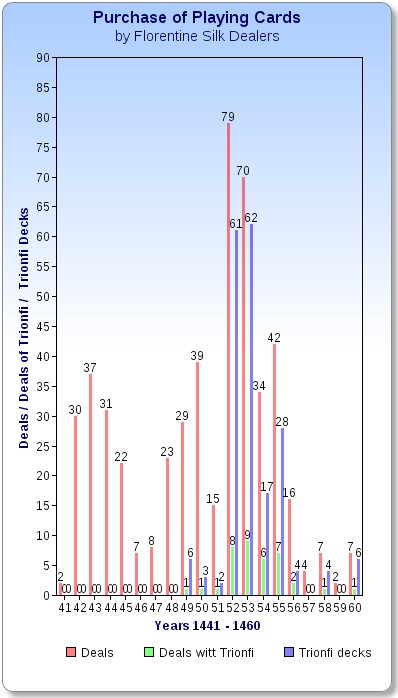1431-1460: NAIBI ACQUIRED BY SILK-DEALERS
by Franco Pratesi, 20.04.2012
Table of contents
1. Introduction
2. Preliminary data
2.1 From book 12791
2.2 Uscita books
2.3 Ricordanze books and silks-cards trade
2.4 My assemblage
3. Suppliers, packs and prices
3.1 Antonio di Dino
3.2 Niccolò di Calvello
3.3 Antonio di Simone
3.4 Matteo Ballerini
3.5 Minor suppliers
4. Discussion and comments
4.1 About the artists
4.2 Competition among suppliers
4.3 Prices of the cards
4.4 Frequency of purchases
4.5 Trionfi
5. Conclusions
1. Introduction
This note can be read independently of any other, but to associate it with a previous one can be useful;(1) actually, most of the subjects encountered here are well known to anybody, who remembers what has been found in the former note. The archive studied is still the AOIF(2) with its useful inventory of the account books kept there, (3) including the Estranei section of our interest. Not only: the books studied here still belonged to the same associated silk-dealers, Lorenzo di Bartolo and Matteo di Zanobi.
As acknowledged in the previous note mentioned, one of these books had been indicated to me by Thierry Depaulis,(4) on the basis of an article by Dario A. Covi,(5) and it has already been used for another recent note of mine.(6)
Most of the goods traded in the store are of course silks, but our specific interest is focused on a secondary part of the trade, playing cards, which seemingly have nothing to do with silks. In my previous note I had collected many data on naibi, taking them out from the long lists of various goods sold by our silk-dealers.
Now I intend to go on. It is essential however to understand the special kind of this continuation. Indeed, I have gathered here a very rich set of information on playing cards traded, which is not just a prolongation of the former set. Instead of a continuation, we should speak here of the other face of the trade: in the former study, I described all the card packs that I found sold by the silk-dealers; here, I intend to report information on all the cards packs that I have found recorded as acquired by the same silk-dealers, in the same years.
We are now ready to inspect these records directly, as collected in the following tables. The abbreviations used should already be familiar to readers of the previous notes. As for size, they are GRA or grandi, large; MEZ mezzani, middle; MZL mezzanelli, the same as mezzani, or slightly different; PIC piccoli, small. As for kind, they are SCE or scempi, single; DOP doppi, double; DOR Dorati, gilded; CAR c(h)arte, cards; FIN fini, good quality; FOR di forma, made with woodblocks; RIM rimboccati, with folded edges; TRI trionfi. The abbreviation MIX, mixed, "di più ragioni", can involve both size and kind and clearly corresponds to the most uncertain values for the prices.
The date is in the format 14yymmdd. All the prices are reduced to soldi, (s.) changing into non-existent cents their fraction in denari (d.), one of which was 1/12 of 1s. (This explains the frequent appearance of N,67 or N,33 or similar approximate values.) An asterisk indicates that the price is an average value derived from the total amount recorded; it may be present for a single pack too, in case its price has been agreed upon.
There are several words that I am not sure to have read correctly and they are indicated as Name[?]. This should not be discouraging for further studies in these books: actually the handwriting is here better legible than average!
2. Preliminary data
2.1 From book 12791 – Entrata e Uscita A
This book(7) seems to be the first of a series of three similar books, but actually is of a different kind. Its contents are actually various: initially we have about thirty leaves of receipts, then four leaves beginning with number 25 with entries of the same kind as the following books, then many further pages of expenses for production, and similar matters. In other words, this whole book is interesting for us just due to its leaves 25 to 29, and it is from there that I have deduced the following table.
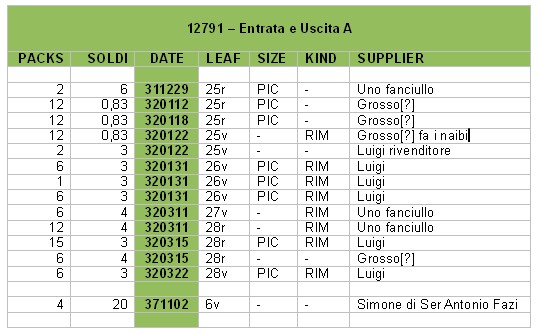
The corresponding dates are earlier than the limits indicated for the book and also earlier than most of the other records that I could study up to now - even the suppliers are not the same as we find later on. Luigi rivenditore certainly was not a cardmaker, but just a small retailer. Grosso[?] is thus the only maker recorded here; we have not yet encountered him elsewhere, and even his name, or nickname, is uncertain. Uno fanciullo, a boy, as a supplier of goods, is a rather frequent occurrence; unfortunately for us, any such indication does not help to trace the makers of the products.
The last entry corresponds to a purchase of four packs of naibi from Simone di Ser Antonio Fazi; his profession is not indicated, but we can assume him to be a cardmaker. It is unavoidable for us to connect him with Antonio di Simone, maybe his son, whom we find later on as a maker of expensive cards. Important is that we find here his family name too, and it has been possible to find him in Catasto 1427, the known series of books with much information on Florentine families.(8) I could read there that he was 33 and lived together with his wife, 25, and a third person; I was certain to find his child Antonio di Simone recorded together with his parents - unfortunately for us (and maybe for him) the third person of the family was instead by then... his mother-in-law.
2.2 Uscita B and C books
Compared to the others, the account book already examined is earlier and different. Let me first describe which are the following books that I have studied. The main sources of the following data are books 12792(9) and 12793(10); the latter one is precisely the book that was suggested by Covi as a useful source of data for naibi trade. These books are Uscita books, where expenses and purchases are recorded day after day; obviously, we find playing cards inserted along with the most various goods, mostly of silks trade.
It is possible that a single entry for a cardmaker corresponds to several kinds of packs, and sometimes we find only the total cost. In these cases, sometimes I used an average cost (with an asterisk); in other cases, instead of the unit price, I have inserted the total amount denoted by a "t" after the soldi number.
Often the cardmaker brings his packs in person to the store. In many cases, however, the packs are recorded as brought by a child or a boy of the workshop, and sometimes it becomes difficult to recognise the name of the artist involved or even that the entry corresponds to playing cards.
In a few cases, the price recorded corresponds to a part of the value of the cards, and it is impossible to deduce the unit price of the packs. The same occurs when the supply consists in different kinds of packs, without any further specification on the relative amounts. I have inserted a question mark in the columns of Packs and/or Soldi when it was impossible to deduce the actual values.
Sometimes we find the same cardmakers recorded for trades different from playing cards. Due to some limits - of space, time, and principally of my patience - I have only copied all the occurrences of playing cards that I have noticed, and nothing else. It has already been a painstaking job, especially because it has been practically impossible, for me, to avoid omissions and mistakes.
2.3 Ricordanze books and the silk-and-cards trade
In addition to the mentioned series of books, I have again examined another one: the same three books of Ricordanze, 12974(11), 12795(12) and 12796(13), which I had already used as source of data on the naibi packs sold by the silk-dealers (1), looking for them within the long lists of various goods sold. Here the entries for naibi are again different: below one or more entries with goods acquired by cardmakers, we find more or less long lists of payments by instalments, mostly by means of naibi packs.
It may be rather unexpected to see how playing cards enter the trade. If our silk-dealers sell playing cards too, as we had already verified, they have to acquire some supply of them; this is obvious, but, at the same time, has apparently nothing to do with silks.
What we find is rather different, at least in some cases, and one has to reflect on the habits of the time in order to fully understand the situation. Typically, it is first our cardmaker to play the purchaser role. He acquires something from the silk-dealers and is debited with the corresponding money amount. This is in the account book the first line of an entry that includes many lines, with a more or less long list of the several subsequent instalments necessary for paying his debt off.
These cases are not an exception. Most trades, of any goods, were settled by instalments and what distinguished the single cases was how many portions we find recorded and how many of them paid in cash or in kind. On the whole, it may be rather surprising – seen from nowadays – that, in correspondence to the countless amounts of money transfers recorded in these books, few coins were actually exchanged.
To find playing cards among payments of cardmakers becomes thus obvious, and we can even understand that in some cases we also find playing cards offered by mercers. It is more probable than usual that several of the last cases have escaped my attention.
2.4 My assemblage
Now I have to explain why I have reported the data from these books in an unusual way; namely, collecting them here according to the single makers who supplied cards to the silk-dealers. As a matter of fact, this seemed to me the nearest approximation towards a possible reconstruction of the account books of the cardmakers themselves - instead of those of the silk-dealers - and that trade is by far the most interesting for us.
This is a very fascinating and new approach to our historical investigation and almost corresponds to what I hoped to find, after realising that many packs of playing cards, seemingly (or sometimes explicitly stated as) produced in Florence, were imported to Rome.(14)
Of course, the result has only a partial character - since we can just verify what cardmakers supplied to our silk-dealers - but this point of view is certainly new and more rewarding than we could ever have expected up to now.
The information is in some cases redundant, with the same packs of naibi recorded in different books; this occurs in particular whenever the same trade is recorded (or should be recorded) both in Ricordanze and Uscita books. Initially, I was happy of this occurrence of double entries, because it allowed me to verify that the trade had been correctly recorded and, what is more, that I had found it and read correctly. Now, I leave to readers the task to find what is clearly wrong in my tables, and what should be checked again.
Let me add a suggestion how to proceed. A first approach would be to behave as young pupils, who have just learnt the meaning of gcd and lcm. You have preliminarily to chose either only to take the data that appear alike in both tables, or instead all the different data, which are present in any table, clearly with dissimilar results. An alternative way is however more right and proper for adults: I wish that somebody is soon able to discover all the omissions and mistakes made in the books of the AOIF by the silk-dealers, and further multiplied by me.
|
Provisional Counting of Playing Card Deals
between Suppliers and Silk Traders (1441 - 1460)
- possibly with errors
|
1. Uscita A (14)
1431: 1
1432: 12
... 1437: 1
2. Antonio di Dino (142)
1441: 2
1442: 8
1443: 23
1444: 30
1445: 14
1446: 7
1447: 4
1448: 8
1449: 8
1450: 10
1451: 5 (1x Trionfi - 2 decks)
1452: 17 (4x Trionfi - 30 decks)
1453: 6
3. Nicolo di Calvello (95)
1442: 3
1443: 10
... 1445: 7
... 1447: 4
1448: 8
1449: 7
1450: 9
1451: 6
1452: 9
1453: 6 + 2
1454: 0 + 5
1455: 2 + 9
1456: 4 + 4
4. Antonio di Simone (80)
1442: 6
... 1447: 6
1448: 7
1449: 10
1450: 18
... 1452: 24
1453: 8
... 1455: 1
5. Matteo Ballerini (149)
1450: 1
1451: 4
1452: 25
1453: 27 (3x Trionfi, 9 decks) + 14 (2x Trionfi, 13 + x decks)
1454: 5 (1x Trionfi, 2 decks) + 20 (1x Trionfi, 1 deck)
1455: 6 (2x Trionfi, 6 + x decks) + 22 (3x Trionfi, 6 decks)
1456: 4 (1x Trionfi, 2 decks) + 4 (1x Trionfi, 2 decks)
1457: 2 + 2
1458: 3 + 4 (1x Trionfi, 4 decks)
1459: 1 + 1
1460: 4 (1x Trionfi, 4 decks) + 3
6. Antonio Trichaglia (?) (6)
1442: 5
... 1453: 1
7. Meo di Ghero (7)
1442: 7
8. Giovanni di Domenico (6)
1449: 3 (1x Trionfi, 6 decks)
1450: 1 (1x Trionfi, 3 decks)
... 1452: 1 (1x Trionfi, 6 decks)
1453: 1 (1x Trionfi, 12 decks)
9. Manetto d’Agnolo merciai (6)
1453: 1 (1x Trionfi, 4 decks)
1454: 4 (4x Trionfi, 14 decks)
1455: 1 (1 Trionfi, 4 decks)
10. Various Suppliers (16)
1442: 1
1443: 4
1444: 1
1445: 1
... 1449: 1
... 1452: 3 (3x Trionfi, 25 decks)
1453: 4 (2x Trionfi, 24 decks)
1455: 1 (1x Trionfi, 12 decks)
SUMMARY (521)
1431: 1
1432: 12
... 1437: 1
... 1441: 2
1442: 30
1443: 37
1444: 31
1445: 22
1446: 7
1447: 8
1448: 23
1449: 29 - Trionfi: 1 Deal / 6 Decks
1450: 39 - Trionfi: 1 Deal / 3 Decks
1451: 15 - Trionfi: 1 Deal / 2 Decks
1452: 79 - Trionfi: 8 Deals / 61 Decks
1453: 70 - Trionfi: 9 Deals / 62+ Decks
1454: 34 - Trionfi: 6 Deals / 17 Decks
1455: 42 - Trionfi: 7 Deals / 28 Decks
1456: 16 - Trionfi: 2 Deals / 4 Decks
1457: 4
1458: 7 - Trionfi: 1 Deal / 4 Decks
1459: 2
1460: 7 - Trionfi: 1 Deal / 6 Decks
Adding these numbers, I get 518 and a mistake of 3 against 521. I don't find the error, I give up on it - at least for the moment.
|
|
|
3. Suppliers, packs and prices
3.1 Antonio di Dino
Antonio di Dino is usually mentioned as "fa i naibi", he produces naibi. This is a usual indication for the corresponding profession. In other cases, we find "dipintore" or painter, mentioned, but this is found more frequently for painters of boxes and cases, than of cards.
If possible, it is useful to understand, which the original profession of the maker had been: the simplest case is when we find a new cardmaker who is the son, or the younger brother of a known cardmaker. The case of Antonio di Dino is somewhat particular, because the first time that we find him in book 12792 he did not supply cards. He was then mentioned as a maker and supplier of abaci, or counting frames (l. 2r – April 1442). Later on, we find him indicated on one occasion as a "tavolacciaio", maker of tables (12793, 25r – 1449).
Apparently, his production corresponded to an intermediate level, not as expensive as the cards produced by Antonio di Simone, but not as cheap as those of Niccolò di Calvello, listed below.
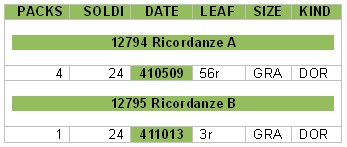
A particularly interesting trade is that of 13 October 1441: the cardmaker supplies a fine pack of naibi as part of a payment. This pack is of the finest quality made by him, as the four packs supplied a few months before; they are priced at 24s., higher than usual, but are naibi both Grandi and gilded. Probably, however, the most interesting indication for us about this special pack is its destination.
As a matter of fact, we learn not only that this pack passes directly from the painter to the silk-dealers, but also that they intend to send it to Venice, where evidently it could be sold, and probably in more favourable terms; this town was very active at the time as an international market, even of art products.
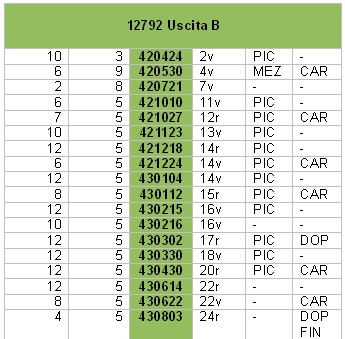
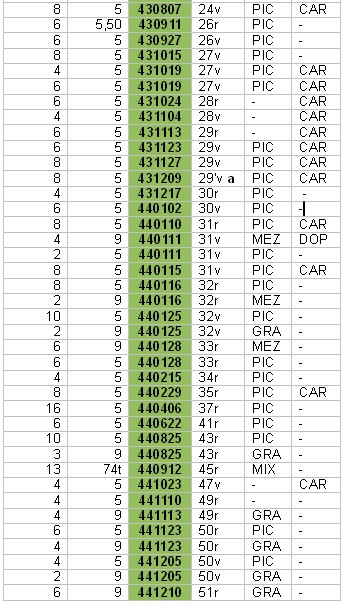
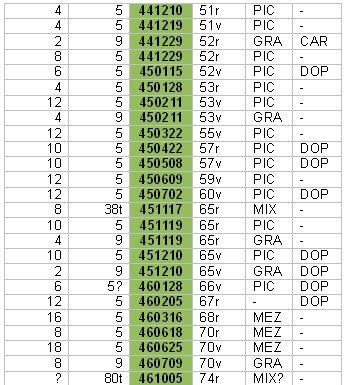
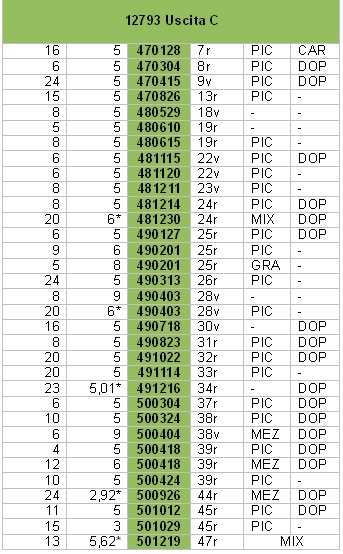
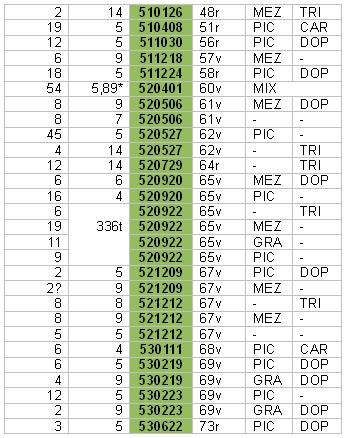

(a) There is a mistake in leaf numbering, with 29 present twice.
|
REPEATED TEXT: Abbreviations:
Franco Pratesi: "The abbreviations used should already be familiar to readers of the previous notes. As for size, they are GRA or grandi, large; MEZ mezzani, middle; MZL mezzanelli, the same as mezzani, or slightly different; PIC piccoli, small. As for kind, they are SCE or scempi, single; DOP doppi, double; DOR Dorati, gilded; CAR c(h)arte, cards; FIN fini, good quality; FOR di forma, made with woodblocks; RIM rimboccati, with folded edges; TRI trionfi. The abbreviation MIX, mixed, "di più ragioni", can involve both size and kind and clearly corresponds to the most uncertain values for the prices.
The date is in the format 14yymmdd. All the prices are reduced to soldi, (s.) changing into non-existent cents their fraction in denari (d.), one of which was 1/12 of 1s. (This explains the frequent appearance of N,67 or N,33 or similar approximate values.) An asterisk indicates that the price is an average value derived from the total amount recorded; it may be present for a single pack too, in case its price has been agreed upon.
There are several words that I am not sure to have read correctly and they are indicated as Name[?]."
Large text |
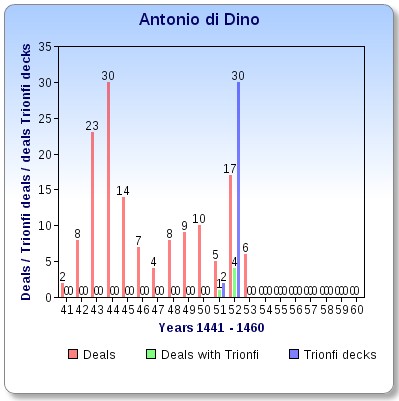
|
|
3.2 Niccolò di Calvello
This cardmaker, "Nicholo di Chalvelo fa i naibi", provides the greatest amount of cards, more than three thousand packs. His supplies are always on a dozen basis – in practice, card amounts that another maker provided in terms of packs, he was able to provide in terms of dozens. Apparently, he had developed a system of production that allowed him to supply most of the packs and at the smallest cost. Only in a couple of cases his cards are indicated as "di forma", but I imagine that all of them were produced with woodblocks (and possibly not even painted).
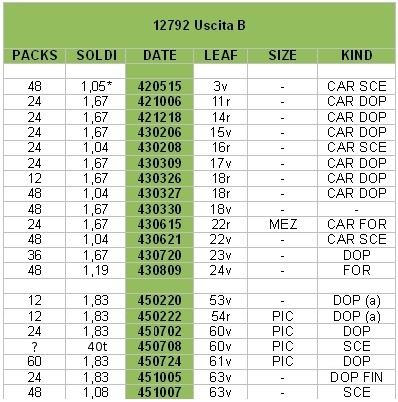
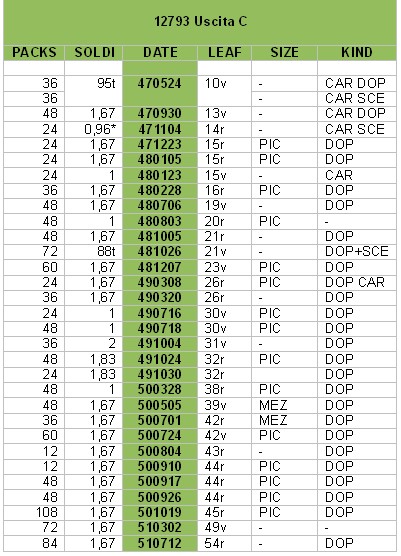
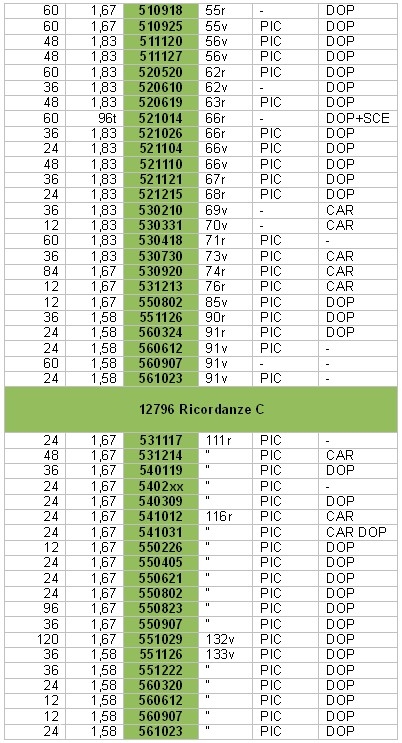
(a) Actually these packs are purchased from Puchio[?] di
Calvelo fa i naibi, maybe another member of the family.
|
REPEATED TEXT: Abbreviations:
Franco Pratesi: "The abbreviations used should already be familiar to readers of the previous notes. As for size, they are GRA or grandi, large; MEZ mezzani, middle; MZL mezzanelli, the same as mezzani, or slightly different; PIC piccoli, small. As for kind, they are SCE or scempi, single; DOP doppi, double; DOR Dorati, gilded; CAR c(h)arte, cards; FIN fini, good quality; FOR di forma, made with woodblocks; RIM rimboccati, with folded edges; TRI trionfi. The abbreviation MIX, mixed, "di più ragioni", can involve both size and kind and clearly corresponds to the most uncertain values for the prices.
The date is in the format 14yymmdd. All the prices are reduced to soldi, (s.) changing into non-existent cents their fraction in denari (d.), one of which was 1/12 of 1s. (This explains the frequent appearance of N,67 or N,33 or similar approximate values.) An asterisk indicates that the price is an average value derived from the total amount recorded; it may be present for a single pack too, in case its price has been agreed upon.
There are several words that I am not sure to have read correctly and they are indicated as Name[?]."
Large text |
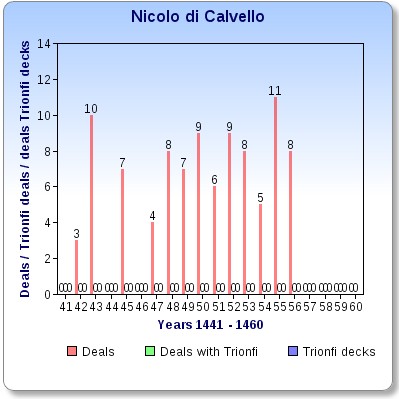
|
|
3.3 Antonio di Simone
Antonio di Simone is usually indicated as "fa i naibi", but among cards supplied by him we seldom find more than a dozen packs; usually he brings to the store a couple of packs, or a little more. On the other hand, his prices are remarkably higher than those of the other makers. We find surprising little variations around a unit price of 9s. In the course of time, this will be nearer to the common price of trionfi, than of naibi.
I suppose that the biggest difference with other products mainly (if not only) consisted in a more accurate decoration. These packs are seldom mentioned as fini, and never as gilded, but some justification should have existed for a price that was about the double than that of packs produced by Antonio di Dino, and five times the usual price for those of Niccolò di Calvello. Probably the indication of mezzani that we find in some cases should be extended to all these packs, because of the constant price; the same for doppi, whereas the fact that we find sometimes these packs mentioned as charte instead of naibi does not appear as a significant difference (still due to the same prices).
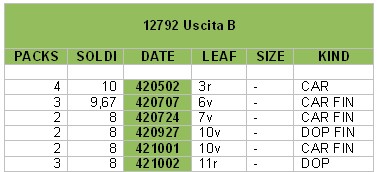
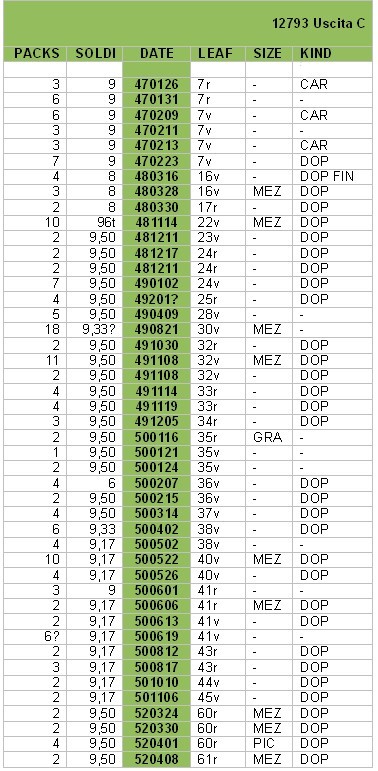
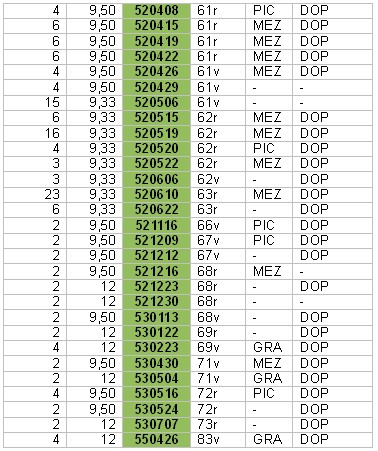
|
REPEATED TEXT: Abbreviations:
Franco Pratesi: "The abbreviations used should already be familiar to readers of the previous notes. As for size, they are GRA or grandi, large; MEZ mezzani, middle; MZL mezzanelli, the same as mezzani, or slightly different; PIC piccoli, small. As for kind, they are SCE or scempi, single; DOP doppi, double; DOR Dorati, gilded; CAR c(h)arte, cards; FIN fini, good quality; FOR di forma, made with woodblocks; RIM rimboccati, with folded edges; TRI trionfi. The abbreviation MIX, mixed, "di più ragioni", can involve both size and kind and clearly corresponds to the most uncertain values for the prices.
The date is in the format 14yymmdd. All the prices are reduced to soldi, (s.) changing into non-existent cents their fraction in denari (d.), one of which was 1/12 of 1s. (This explains the frequent appearance of N,67 or N,33 or similar approximate values.) An asterisk indicates that the price is an average value derived from the total amount recorded; it may be present for a single pack too, in case its price has been agreed upon.
There are several words that I am not sure to have read correctly and they are indicated as Name[?]."
Large text |
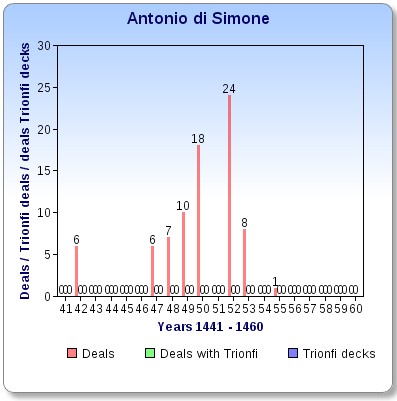
|
|
3.4 Matteo Ballerini
Matteo is indicated in a rather confusing way, more often as Matteo di Bartolomeo or Matteo Ballerini. These names could already correspond to two different makers, and further ones might be present when we find Francesco as father’s name. I am nevertheless fully persuaded that we are in the presence of a single maker, variously mentioned, even if we are not accustomed to find anyone indicated as son either of Francesco or of Bartolomeo. The situation is similar for his profession, although this is not too different from other artists: in 1451, he is recorded in the book as "fa i naibi" on 25 September, and as "dipintore" on 5 October. (Actually he is regularly mentioned as dipintore in the last times.)
Matteo appears relatively late as a supplier to our silk-dealers, and his production seems to be at the same level as that of Antonio di Dino, or of Giovanni di Domenico. His main product was naibi piccoli and doppi, and we can suppose this product to be present whenever his packs were not explicitly indicated in a different way. Also the use of c(h)arte name, instead of naibi, as in other cases, does not appear to represent a significant distinction.
Naibi mezzani have a price that oscillates from 5 to 6s. Trionfi change from 9 to 10s. and it is remarkable that gilded trionfi were priced about the double than those without gold (as supported from other cases too).
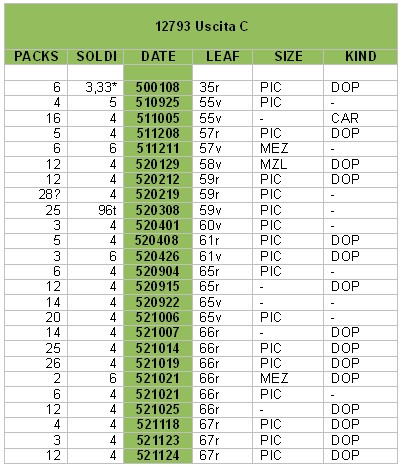
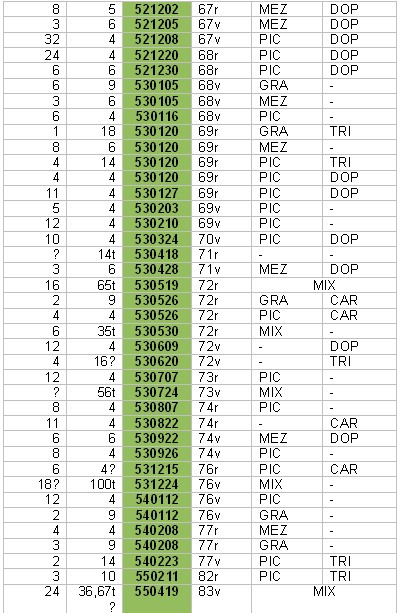
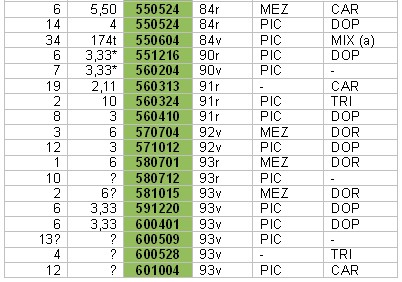
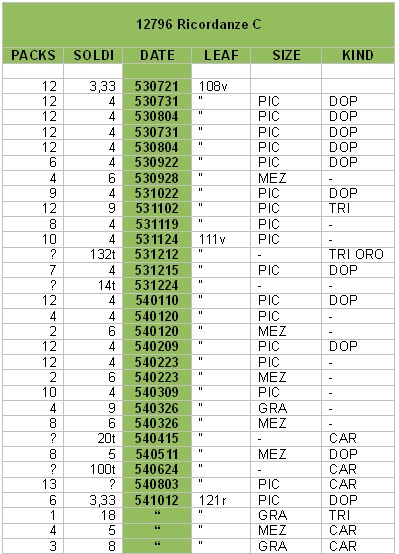
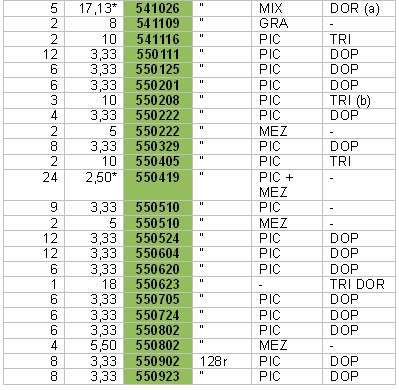
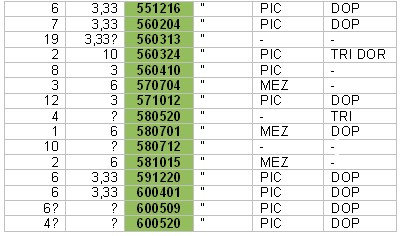
(a) Among these packs of various kinds we find unknown quantities of gilded cards and trionfi.
![]()
(a) Only part of the packs are gilded.
(b) Sanzoro, not gilded.
|
REPEATED TEXT: Abbreviations:
Franco Pratesi: "The abbreviations used should already be familiar to readers of the previous notes. As for size, they are GRA or grandi, large; MEZ mezzani, middle; MZL mezzanelli, the same as mezzani, or slightly different; PIC piccoli, small. As for kind, they are SCE or scempi, single; DOP doppi, double; DOR Dorati, gilded; CAR c(h)arte, cards; FIN fini, good quality; FOR di forma, made with woodblocks; RIM rimboccati, with folded edges; TRI trionfi. The abbreviation MIX, mixed, "di più ragioni", can involve both size and kind and clearly corresponds to the most uncertain values for the prices.
The date is in the format 14yymmdd. All the prices are reduced to soldi, (s.) changing into non-existent cents their fraction in denari (d.), one of which was 1/12 of 1s. (This explains the frequent appearance of N,67 or N,33 or similar approximate values.) An asterisk indicates that the price is an average value derived from the total amount recorded; it may be present for a single pack too, in case its price has been agreed upon.
There are several words that I am not sure to have read correctly and they are indicated as Name[?]."
Large text |
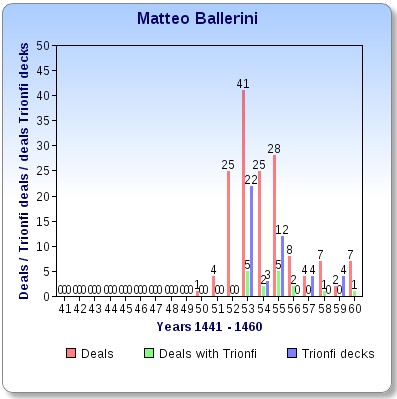
|
|
3.5 Minor suppliers
a. Antonio Trinchaglia[?]
This is one of the many Florentine cardmakers, "che fa i naibi", with name Antonio. He may coincide with one or more of the other makers found here and there under the same name. The name of Trinchaglia, possibly a nickname, I could not read with certainty.
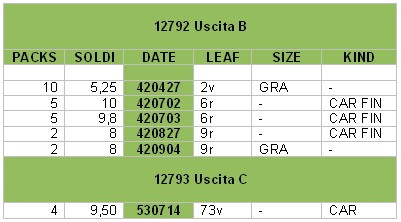
b. Meo di Ghoro
Meo di Ghoro che fa i naibi is a cardmaker that supplies naibi to the silk-dealers only for a few months of 1442. I could not find his products even in other stores that I have "visited" up to now. His prices were in the high range, comparable to those of Antonio di Simone, who was apparently preferred as a regular supplier – starting from about the same time.
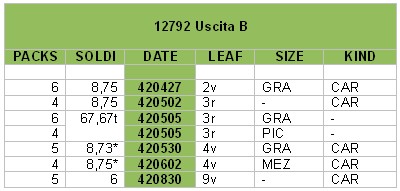
c. Giovanni di Domenico
We only meet Giovanni di Domenico at the end of 1449 and he enters the records in an interesting way. He is at once indicated as dipintore, a painter, and his first supply contains both six packs of trionfi and eight packs of naibi doppi. At least one pack of trionfi had already been sold by the silk-dealers (January 1445)(1), but these seem to be the first packs recorded as acquired. The total price is 4L.18s. and if we assume that the naibi were priced at 4s. as those acquired a few days later, a unit cost of 11s. can be deduced for trionfi, a relatively low price, very similar to the 9s.6d. cost of naibi made by Antonio di Simone.
It seems that the production of Giovanni could substitute, trionfi apart, that of Antonio di Dino, at a similar level of overall quality, but he did not become a frequent supplier, except for a few trionfi. In alternative to Antonio di Dino, whom we find also later on, Matteo Ballerini was apparently preferred, for unknown reasons (maybe just more purchases of silks).
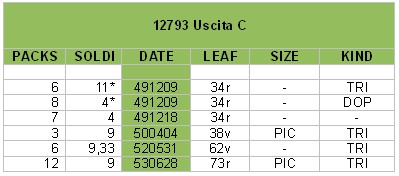
d. Various suppliers
Sometimes we find cards from other suppliers, different from the "usual" cardmakers. Also a mercer (as typically Manetto d’Agnolo) could sometimes pay part of his debts with playing cards that he had acquired from elsewhere.
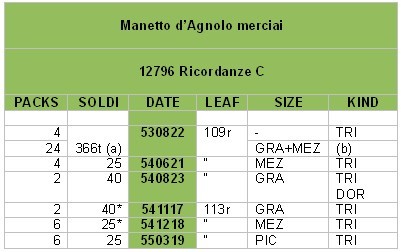
(a) The total recorded is L.18s.6. which would give 13s.* as average value for the three different packs. I could not find how to convincingly divide it into the three parts mentioned. Assuming 25s. for trionfi the average for grandi and mezzani would be too high at 11,08s*; more likely appear 40s., and 8,58s.*, respectively.
(b) these cards are indicated as by Paparello.
In a few cases, we find recorded "un dipintore", a painter, who evidently had some reason (or the silk-dealers had) not to record his name in the account books. In other cases, we find "un fanciullo", a boy, or "una donna" a woman; these are not exceptional entries in the books: on the contrary, it is a frequent occurrence that of "un viandante", a wayfarer, "un forestiero", a foreigner, "un amico", a friend, or similar attributes for suppliers, who are recorded in an anonymous way.
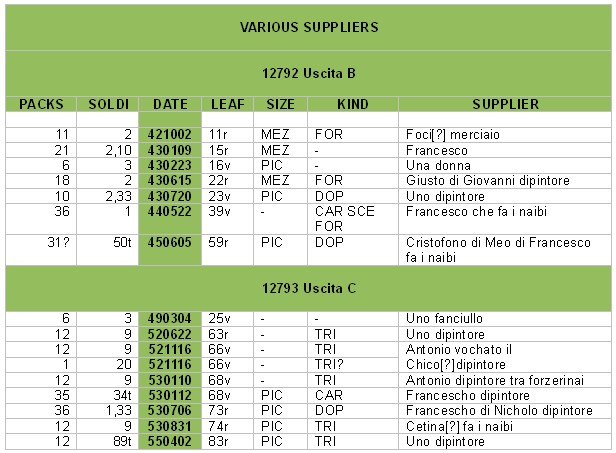 It is easy to suppose that any painter (or at least most of them) who supplies a dozen trionfi priced 9s. is the same person, even if recorded under different names.
It is easy to suppose that any painter (or at least most of them) who supplies a dozen trionfi priced 9s. is the same person, even if recorded under different names.
It may be worth noting that the fraction of trionfi in the cards acquired from these scattered suppliers of the early 1450s is greater than average. This may indicate that the "regular" suppliers of the store were not able to meet the demand of the silk-dealers for this particular product, but to be sure we should find some confirmation from other sources.
|
REPEATED TEXT: Abbreviations:
Franco Pratesi: "The abbreviations used should already be familiar to readers of the previous notes. As for size, they are GRA or grandi, large; MEZ mezzani, middle; MZL mezzanelli, the same as mezzani, or slightly different; PIC piccoli, small. As for kind, they are SCE or scempi, single; DOP doppi, double; DOR Dorati, gilded; CAR c(h)arte, cards; FIN fini, good quality; FOR di forma, made with woodblocks; RIM rimboccati, with folded edges; TRI trionfi. The abbreviation MIX, mixed, "di più ragioni", can involve both size and kind and clearly corresponds to the most uncertain values for the prices.
The date is in the format 14yymmdd. All the prices are reduced to soldi, (s.) changing into non-existent cents their fraction in denari (d.), one of which was 1/12 of 1s. (This explains the frequent appearance of N,67 or N,33 or similar approximate values.) An asterisk indicates that the price is an average value derived from the total amount recorded; it may be present for a single pack too, in case its price has been agreed upon.
There are several words that I am not sure to have read correctly and they are indicated as Name[?]."
Large text |
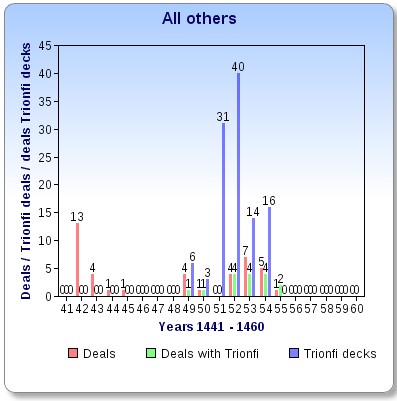
|
|
4. Discussion and comments
4.1 About the artists
In comparison with previous notes, the situation is now somehow reversed. We have no longer to study who were the buyers of card packs recorded, nor where were they active. In other words, apart from a few interesting exceptions, we now collect no information on the destination of the playing cards. We see the contrary movement, where the cards came from. In principle, one could expect that the cards traded were totally or in part produced elsewhere and just arrived in Florence along one of the many trade channels that were already active for centuries.
Fortunately - or unfortunately that it may be considered - we do not obtain interesting information on any place of card production… except for Florence itself. In a few cases, our silk-dealers acquired the cards for their workshop from other traders. Generally, however, they acquired the packs to be sold directly from the Florentine makers themselves.
This is for us a very important situation. It almost corresponds to the fulfilment of a dream: to inspect the account books of Florentine cardmakers! Indeed, the packs that we find listed in our accounts books, and their prices as well, are exactly the same as those that we could have read in any of the account books of the cardmakers. (The obvious important difference is that we get no idea of how many further purchasers our cardmakers provided with their packs.)
It is worth noting that the situation of cardmakers in Florence was different from that of other places. Here we find no indication of a kind of guild of cardmakers, as it existed in about the same time in other German, French, or even Italian towns. On the contrary, we find several kinds of craftsmen mentioned as involved in card making. This could correspond to real differences in their activity, but could also correspond to makers who had chosen to matriculate in a different Arte.
Painters were accepted in the Arte dei Medici e Speziali, but the entrance fee was higher and many of them preferred to matriculate in a minor Arte, as forzerinaio, legnaiolo, or even not to matriculate in any Arte. This could change for the same person in the course of time, with upwards changes in the "degrees" mentioned, in connection with a remarkable success of their activity. This particular situation is described in some detail in a book dedicated to the Florentine painters of the time.(15)
It seems that the best attribute for a cardmaker was that of dipintore, or painter. This we find in some cases, but more frequently any artist thus mentioned provided the silk-dealers with painted boxes and cases, or similar products. The most frequent indication for card suppliers we find just as "fa i naibi", makes naibi. Evidently, there were craftsmen who had already become specialists in this production; often this activity passed from father to son and continued in the same family.
My impression is that these makers did not work in the same way: for instance, some of them produced low-cost packs, others high-quality ones. Moreover, it is possible that further specialisation already existed, with the production process divided into several stages, with craftsmen experts in each of them, to end with the painter, who could be only present for painting the figures on the cards.
On the other hand, we find evidence that a cardmaker could even produce different objects, such as for instance Antonio di Dino, who at least initially was an expert in the production of tables; or as lo Scheggia, whom we knew as a "normal" painter, in case dedicated to the production of Cassoni, and only recently have found as a naibi painter.(16)
4.2 Competition among suppliers
For the same purchaser, we find several suppliers. How did they compete for improving their own trades? Of course, we have no direct or complete information about that. When examining the trades, we clearly see that the various makers mainly offered different goods. My impression is that no serious competition existed with other Florentine makers, whom we never meet here. The reason why a limited number of makers supplied our silk-dealers with playing cards is unknown.
I imagine that some border cases were excluded at once: no maker was needed who provided cards cheaper and in bigger quantities than Niccolò di Calvello; no maker was needed who could provide more expensive and precious cards than Antonio di Simone. How many makers were thus eliminated I cannot evaluate exactly. It is possible that nobody in Florence could produce cards cheaper than Niccolò; on the other hand, we do know from other sources Florentine makers, who produced more expensive cards and trionfi, to begin with Paparello and Filippo di Marco; in particular, the prices for some trionfi made by the latter artist in the 1450s are incomparably higher than those recorded here.(17)
Sometimes we find different makers supplying packs on the same day. Was this by chance, or did it correspond to a requirement of larger supplies by the silk-dealers? The only fact that I am certain of is that our silk-dealers had not summoned the different makers by phone. I like however better to suppose that whenever the cardmakers met in the store of the silk-dealers, this occurred by chance.
If any cardmaker was not interested in silks by any means – after all, a possible situation – he plausibly had a clear disadvantage in supplying his production to our dealers. These particular cases could have somewhat adjusted the usual rule that any purchaser changes supplier, whenever he finds a new one who provides better specimens at the same cost or lower prices for the same quality.
4.3 Prices of the cards
It is possible that in a near future the numbers reported here for packs traded will further augment after a more accurate inspection on the books; it is a pleasing idea for me that somebody may be stimulated to study these books further. However, these data should already be enough for some analysis by interested readers.
As for the change of prices in the course of time, we should also allow for the corresponding changes in purchasing power of money. This I can do later on, especially if I realise that the difference is significant enough. For the moment, I am satisfied with the appearance of rather constant prices for the various qualities of packs on sale. This may well be a first approximation only, but my impression is that we are in front of a stable market with continuous supplies and purchases, at fairly stable prices.
What should not escape attention is also to examine the difference of prices, between packs coming in and out of the store. As obvious, the same packs are seen as higher-priced when sold than when acquired by our silk-dealers, but the difference is not much greater than 10%, something that now might be only enough for some outlet stores, whereas we are here in front of modest retailers. The difference in comparison with present-day sellers can easily be explained by increased expenses in keeping an active store nowadays, but also at that time mark-ups were more common in the range of 20-25%.
4.4 Frequency of the purchases
I have collected so many data on card packs acquired in the course of more than twenty years, that some kind of statistical analysis becomes feasible. In particular, we have now made a great progress in comparison with the packs sold by the same silk-dealers: in that case, we were certain that only a fraction of the packs sold had been recorded. In the present case of packs acquired, we can instead rely on a fairly complete knowledge of the whole set of packs that entered the store.
Nevertheless, we find in these data some information that is somewhat confusing and leaves us with the necessity of a special attention in deriving conclusions from these numbers.
Let me take the frequency of purchases as an example, or the frequency of sales, if seen from the cardmakers point of view. This is not a continuous function, with a regular shape: only for certain months the sales have a constant behaviour, with cardmakers who bring their products in almost the same amount and about at the same time intervals. More often we see periods in which no more packs are offered, or acquired, alongside of other time intervals, in which the trade is many times more active than usual.
Unfortunately, we have no information on the reason of similar changes. We do not even understand whether this could depend more on the makers or on the purchasers. In other words, we should never forget that we are not really in front of the account books of the cardmakers, which so much we would like to find out, but only of a part of them, and nobody knows how large this fraction could be!
In particular, we can easily imagine that the amounts of packs purchased were related to the amounts that the silk-dealers expected to sell and therefore we could directly see whenever naibi were more or less used, in general. However, we have seen that a bigger supply of packs from a maker could instead just indicate that the maker himself had bought something more expensive than usual and had to pay his debt with more packs than in other times.
4.5 Trionfi
For many experts, trionfi represent a very special field for study, much more interesting than ordinary playing cards, as if the two articles had little – nearly nothing - in common. Actually, the situation can appear to be worse: lots of experts are not even interested in the whole family of trionfi packs, but just in one and only one of them, which had 78 cards exactly. (By the way, the most important trionfi packs that have been used widely, and for centuries, in the Central-Italian regions of my focal interest had either 97 or 62 cards.) Let me thus comment on a few points concerning trionfi cards.
First of all, may I remind the idiom "naibi di trionfi", which compels the experts above mentioned to insert their study into the more general field of playing cards. In our account books, there is at least one such quotation for Antonio di Dino, on 29 July 1452, already communicated in a note of mine.(6) (I am waiting for the authorisation to publish a photo of this document.) The similar idiom "naibi a trionfi" had already been recorded a dozen years earlier, in the very first case (to our knowledge) in which the name trionfi ever appeared.(18)
I understand, however, that trionfi may induce a greater interest in most readers. They find here an unbelievably rich source for their customary debates. To find more than one hundred and a half trionfi in these early years was probably unexpected by everybody (except for me and a couple of other historians).
To me personally, the most puzzling data in these long lists are those that are… missing there. I mean, it is important to see when trionfi appear in these lists, but it may be even more important to verify when trionfi did not yet appear. These data, which must be considered as early for the trionfi subject, are not early enough for my expectation – I imagined that earlier dates could have been found here, down through the 1440s, and possibly the 1430s.
When Ser Giusto Giusti had his trionfi pack made in Florence in 1440,(18) he did introduce in his "new" pack nothing else than the coat of arms of its beneficiary. This pack was extraordinary for that reason, and possibly for a greater care in producing and painting. However, makers of trionfi were already active in Florence and nobody knows how long.
It is even possible that trionfi were introduced as a new pack before this name was attributed to them. Unfortunately (for me) I don’t see here suitable names before trionfi: Av(v)antaggiati is not enough, Doppi I saw at once as a possibility, but must acknowledge its negligible plausibility, Corone or crowns hardly could correspond to something of the kind, Imperatori I never found in these lists.
In particular, it is interesting to check when our cardmakers began to supply trionfi to the silk-dealers (which should not be assumed however as the initial date of their production, and even less so for other makers). If I have seen correctly, I can quote: Giovanni di Domenico December 1449, Antonio di Dino January 1451, Uno dipintore June 1452, Antonio-Chico November 1452, Antonio fra forzerinai January 1453, Matteo Ballerini January 1453, trionfi resold by mercers August 1453, Cetina[?] August 1453, Maybe a couple of these dates correspond to the same maker, but in any case they appear rather near to each other.
Regular suppliers Niccolò di Calvello and Antonio di Simone were seemingly uninterested in that production, perhaps for different reasons: the former because he was clearly specialised in low-cost items, the latter maybe for the contrary reason - any trionfi pack made by him would have been priced too high for the market.
Of course, our present basis within the store of the silk-dealers may well be rather unsuitable for checking the local spread of trionfi in a reliable way. However, if in the early 1440s, or even earlier, this pack was already commonly produced and used, some trionfi should have passed through the store of our silk-dealers, be it only for sending them… to Venice, if they were too expensive for the local market.
5. Conclusions
With the results of this research a new large set of card packs has been found recorded for the 1430s to the 1450s. In principle, this should correspond to that already provided with the previous research on cards sold by the same silk-dealers - only corresponding prices should be lower for cards acquired. However, we knew that all packs recorded were only a part of those actually sold (apart from the fact that everywhere I may not have noticed some of the packs recorded). Therefore, the new research on cards acquired brings now a lot of additional data.
A new interest is moreover provided by the fact that the cardmakers themselves are directly involved in this trade. Never before had I arrived so near to the workshop of a Florentine cardmaker of that time, and its production. We could not obtain a complete view of the whole production, but at least a partial insight we did obtain. This is much more complete and near to the target than any other information that I know from elsewhere.
Fact is that here we are not in front of makers who produced a few card packs: we find that the local production was already at a high quantitative level. On the other hand, as for producing by then card packs at a high qualitative level, this could easily be expected by anyone familiar enough with the works of the Florentine artists of the time.
Footnotes:
(1) Franco Pratesi: Naibi sold by Silk Dealers (2012)
(2) Istituto degli Innocenti / Research; Franco Pratesi: 1447-1449 - Naibi on Sale (2012)
(3) http://www.istitutodeglinnocenti.it/defi/Isis?Conf=/opt/defi/DefiConf/defi.sysn
(4) Thierry Depaulis, Personal Communication, 04/02/2012.
(5) Dario A. Covi, Prospettiva, No. 12 (1978) 61-72.
(6) Franco Pratesi: Naibi by the Dozen (2012)
(7) AOIF, 12791 «Entrata e uscita A», 13/03/1437 - 16/05/1441.
(8) ASF, Catasto, 69, l.432-433.
(9) AOIF, 12792, «Uscita B», 17/04/1442 - 22/11/1455.
(10) AOIF, 12793, «Uscita C», 17/10/1446 - 02/11/1461.
(11) AOIF, 12794, «Ricordanze A», 01/03/1437 - 17/11/1441.
(12) AOIF, 12795, «Ricordanze B», 27/06/1441 - 05/10/1446.
(13) AOIF, 12796, «Ricordançe C», 12/10/1446 - 23/03/1457.
(14) 1453 An early Arrival of Triumphs into Rome (2011)
(15) Werner Jacobsen, Die Maler von Florenz zu Beginn der Renaissance, Dt. Kunstverl., München 2001.
(16) Franco Pratesi: 1447-1449 - Naibi on Sale (2012)
(17) Franco Pratesi: 1453-1458 Florentine triumphs by Filippo di Marco
(18) Web discussion: Florence 1440 - New Earliest Reference to Tarot
|
|
Side bar pictures and text added by Lothar Teikemeier






























